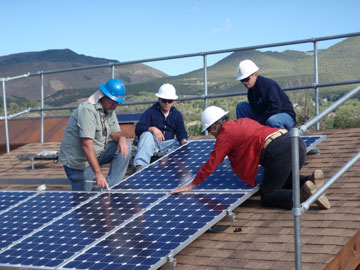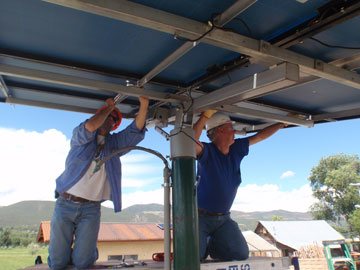
The number of solar training courses has exploded in the last two years thanks to the allocation of federal stimulus money to colleges, private institutions and nonprofit groups to train the next generation of renewable energy workers. But despite the Obama Administration’s vote of confidence in solar technology as the economy’s next great driver, it remains unclear whether solar training courses — which can run thousands of dollars per course — are necessary to enter the solar field or keep skills current once working in the field.
With the release of the stimulus funds, the number of courses “has increased 2000-fold,” says Verve Solar owner and consultant Liz Merry. “There were hardly any courses available four years ago.” The increase, she adds, “is a little cart before the horse.”
According to federal estimates, just 225,000 jobs have been created or saved in the renewable energy industry since the stimulus money was distributed, and many solar hopefuls are finding themselves unemployed after completing their coursework. Administration officials and experts argue that the growth of the renewable energy industry requires the implementation of rules and regulations that favor renewable energy over fossil fuels alongside workforce development programs. Without them, they say, solar training will fail to spur job growth.

Johnny Weiss, co-founder and executive director of Solar International, sees the state of the job market differently. “The solar industry is growing rapidly and there is a broad job market right now,” he says. “There are also sales people, administrative people and the distribution and manufacturing side. There are job opportunities at all levels.”
The solar industry is indeed growing. The United States is expected to surpass Germany as the world’s biggest market for solar power in 2011, according to study by investment firm JP Morgan Chase, and it is arguable that the job market has just not had enough time to expand since the additional solar training courses were implemented.
So while solar wannabes wait for job creation to catch up with their ambitions, should they be investing their time and money to get trained?
“If you want to be an installer you need some training, obviously,” Merry says.
But studies show that for the last ten years, workers entering the industry have acquired their skills through on-the-job training and free training offered by utilities, federally funded solar programs and nonprofit organizations such as the Interstate Renewable Energy Council. Is that sufficient to land a job in today’s ultra-competitive job market?
“If you have courses and workshops under your belt it is a very favorable way to distinguish one potential employee from another,” says Weiss. “Having taken the initiative on your own gives a distinct advantage over an applicant that has the desire but has not taken the time to learn about the job he has applied for.”
In a tight job market that might determine who gets a paycheck and who stands in line at the unemployment office, he says.
“Lots of people certainly get solar jobs and generate their own companies without getting solar training,” says Merry. But, she concedes, completing training courses “is probably a faster way in to the industry.”
Weiss advocates a mix of educational training and on-the-job learning.
“It is true, you can learn [solar installation skills] in the field but the reality is that there is a place for skilled vocational education,” he says. “Ideally those things work together to create the necessary skills.”
A trend elsewhere in the green industry indicates that on-the-job and free training may indeed be insufficient in producing knowledgeable and effective workers.

Commercial construction firm McCarthy Building Cos., which operates offices around the country, recently implemented a green credentialing program for its employees through the U.S. Green Building Council to address the lack of green training available to builders.
“After taking a hard look at all the training out there, we found it wasn’t builder-focused and it doesn’t help our people do better work in the field,” says Chad Dorgan, McCarthy’s vice president for quality and sustainability. “I did lot of the free training available out there and it is very limited in the knowledge it offers. We did not feel it was a good use of employee time.”
McCarthy’s program requires its employees to complete 30 hours of training in 1-1.5 hour increments every two years and focuses on what builders should do during pre-construction and construction to make the construction process more sustainable. A big emphasis is on project sequencing and pre-emptive planning.
“For example, a simple thing like a shading device helps bring daylight into the building,” says Dorgan. “We can act far in advance by sequencing construction to put them in earlier,” which lessens the amount of temporary lighting that needs to be installed — and the amount of waste and pollution created — during construction, he says.
“While the majority of green projects focus on the recycling of the waste created due to the construction process, this actually misses a huge sustainability opportunity — eliminating the production of the waste itself,” Dorgan says. “The best way to identify and eliminate construction waste is to use an ongoing preemptive planning process that systematically helps identify the waste and then implement a series of activities to actually eliminate the waste throughout construction,” which McCarthy’s program is training its builders to do, he says.
Teaching the green practices and procedures embodied in McCarthy’s courses is becoming something the construction industry is increasingly embracing, according to Dorgan.
“The feedback I have gotten is that everyone is looking for something like this,” he says. “They want to maintain their accreditation and they want to get value out of it.”
If the trend toward formal green training in the construction industry continues, Dorgan says McCarthy will likely make its program available to other building companies.
If training is important, then, which types of institutions and programs give students the biggest return on investment? Comparing them is “sort of like comparing apples and oranges,” says Merry, but there are factors to watch for that can make the choice easier.
First, the institution or program should be accredited or the trainer should be certified under IREC’s Institute for Sustainable Power Quality Assessment Framework. IREC, a nonprofit group broadly recognized by government and industry as a trusted player in the renewable energy field, looks for evidence of “quality assurance, quality improvement and fiscal stability” when making accreditation decisions, and asserts that accreditation and certification are “a signal to students, employers, government officials and funding sources that standards for the curriculum, student services, and trainers have been met.”
Students should be wary of institutions and programs that advertise accreditation from an unrelated accrediting body but lack the IREC stamp of approval. The Sonoran Desert Institute in Arizona, for instance, prominently boasts its Distance Education Training Council accreditation on its website but its actual curriculum is unaccredited.
Second, courses differ markedly in length and cost. Many of the courses offered by community colleges and nonprofit training organizations such as Solar Energy International are several weeks long — allowing students to dive in to material in greater depth and to better familiarize themselves with the equipment they will be working with in the field — while many other trainings run for just one day or one week. If possible, experts recommend investing in a longer course.
“When you study for a whole month, from nine to five, and learn design, installation, safety procedures and best practices of residential and small commercial solar systems, that is ideal,” says Weiss.
Accredited community college courses are the cheapest investment for the greatest amount of training, although nonprofit training organizations, while more expensive, will also impart the necessary skills.
In fact, SEI and similar nonprofit solar training organizations around the country are partnering with community and technical colleges to develop the solar workforce. The Department of Energy allocated $27 million, including $10 million in stimulus funds, to The Solar Instructor Training Network in 2009 to train instructors in solar system design, installation, sales and inspection, in order to subsequently train students at community and technical colleges. IREC became the network’s national administrator earlier this year.
The Rocky Mountain Solar Training Consortium, comprised of SEI, Salt Lake Community College and Utah Solar Energy Association, won a $3.1 million grant from DOE last year to train trainers via in-person and online courses to teach solar photovoltaics and solar heating and cooling installation courses at community and technical colleges in the Rocky Mountain region.
“This particular effort is a real breath of fresh air for the development of programs and getting solar into colleges,” says Weiss, who is on the advisory boards of several community colleges. “This is a very important initiative.”
The combination of affordable tuition and the superior training provided by established nonprofit solar training organizations make community colleges the best route for students interested in solar education beyond free training at a time when jobs are scarce and money is tight. Just make certain that you can afford to part with your time and money with no guarantee of landing a job after graduation.

